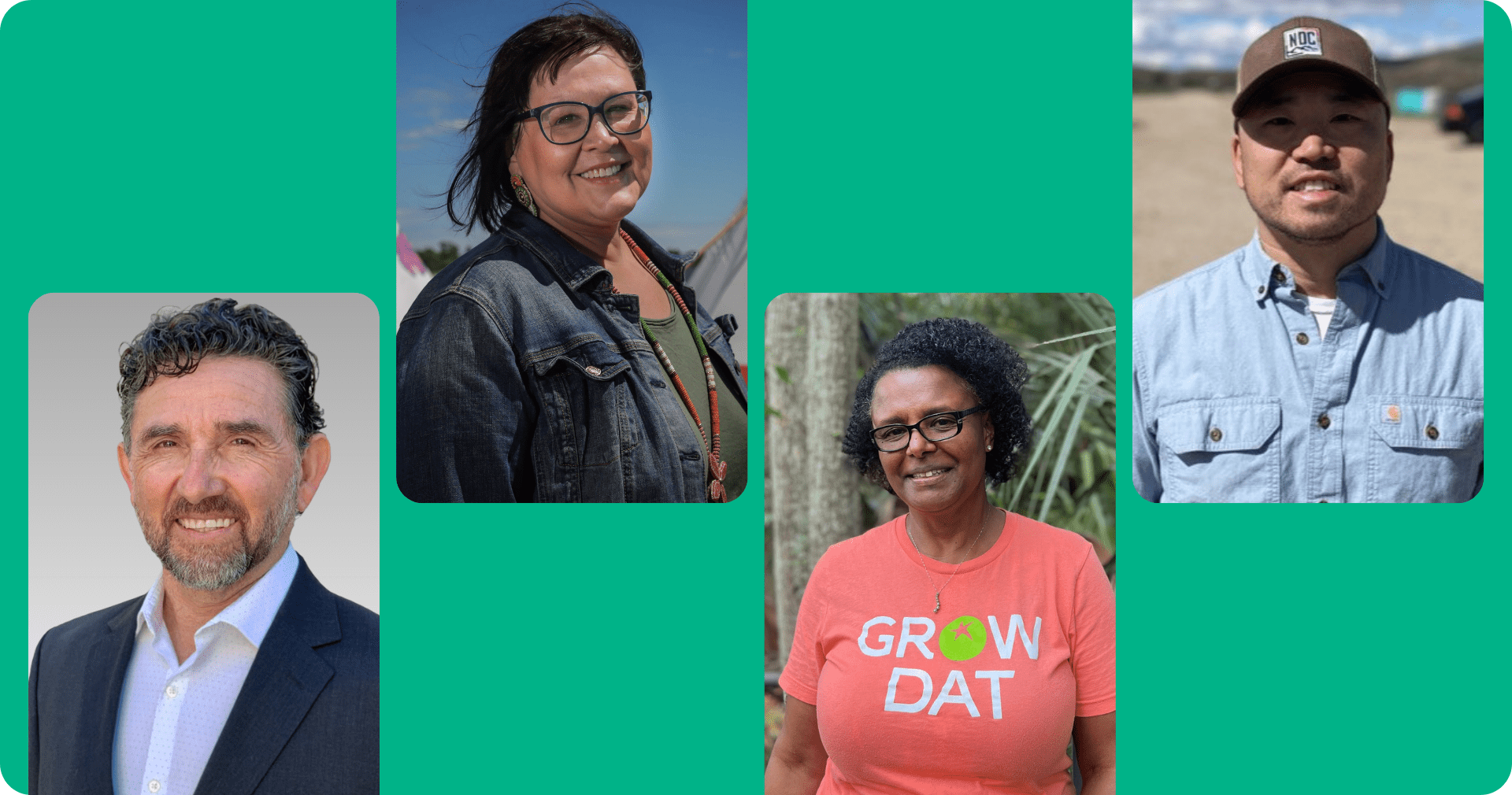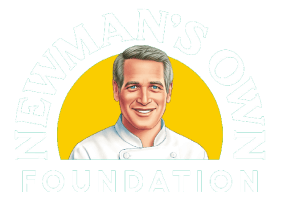Food Justice for Kids Roundtable
A conversation with four food justice leaders (and Newman’s Own Foundation grantee partners) on what a just food system looks like for children and how we can get there by working together.

When it comes to increasing children’s access to nutritious and healthy foods, we know one solution that works. Higher funding for nutrition assistance programs during the pandemic led to a decrease in childhood hunger and when that funding ended, so did the progress made. Many factors, though, combine to contribute to improved outcomes for children—for example, access to nutritious, culturally relevant foods; education about healthy foods and sustainable food systems; and opportunities to grow, gather, and cook food to create lifelong nourishment.
Newman’s Own Foundation supports programs across the country invested in this work. Most recently, we launched the Food Justice for Kids Prize to award a total of up to $1 million dollars over two years, to be shared among 10 organizations.
We sat down with four food justice leaders—all grantee partners of Newman’s Own Foundation—to ask for their perspectives on how best to achieve food justice for kids, on the individual, community, and institutional level.
Participants:
Julie Gable, co-executive director of Grow Dat Youth Farm in New Orleans, Louisiana
Julie Garreau, CEO of Cheyenne River Youth Project in Eagle Butte, South Dakota
Eric Shin, executive director of Nalwoodi Denzhone Community (NDC) in San Carlos, Arizona
Miguel Villarreal, interim co-executive director of the National Farm to School Network in Chicago, Illinois
Newman’s Own Foundation: More than 1 in 6 children in the US live in households where they do not have enough nutritious food to eat or know where their next meal may come from. If you could wave your magic wand, what one thing would you instantly fix or change when it comes to food justice for kids?
Julie Gable, co-executive director of Grow Dat Youth Farm: I would change the whole system. By and large, the food systems today don’t support low income people and communities of color. I would change it to a structure where young people would have access to fresh, local produce anytime they wanted, and people could go into local stores and get that fresh produce. They would know how to grow it using sustainable methods, cook it, and we would have a world where they are living longer, healthier lives. And this magical world would include land ownership for Indigenous people, Black people, and people who have low incomes.
Julie Garreau, CEO of Cheyenne River Youth Project: A just food system would be saying you can have your land back, you can access and grow your own Indigenous foods, access buffalo, foods that are healthy and good for us, and be allowed to eat what you want and need to eat for your own health. It’s about having your own land to grow your own food, have access to fresh, clean water, and so on. It’s all related to fixing some of the injustices that have happened to Native peoples in history, and in the end it’s cultural reclamation too. It’s all wrapped up in a very big wrong that needs to be righted.
Eric Shin, executive director of Nalwoodi Denzhone Community (NDC): I would instill strong values of self and of responsibility in our kids, and a strong value system and the knowledge they can make change necessary in their community. If that foundation was there we would see a big, positive impact.
Miguel Villarreal, interim co-executive director of National Farm to School Network: I would ensure that every school district and community adopted local policy that ensured values aligned with procurement practices and that those policies were enforced. It would mean improved mental and physical health for our students, our farmers being supported, and our school food service employees being trained, plus benefits to the environment, animal welfare, and the economy, which means a healthier planet for our children.
NOF: So many people working in this arena say the system has to change. What does that look like in your organization’s efforts?
MV: Local, state, and national organizations have to ensure children are provided with the healthiest foods and that those come from local farms and should offer culturally relevant meals in those communities. And there’s an urgent priority to reduce and eliminate all highly processed foods in every institution that provides meals to students. When we’re talking about farm to school, it’s fruit and vegetables, yes, but also eggs, dairy, meat, and grains, and also supporting school gardens, which serve as outdoor education centers. We also need to invest in school food service employees, making sure they’re trained and earn a living wage. The NFSN comes up with solutions and works with partners to share best practices, helping to eliminate the obstacles to making sure locally sourced food is being served in schools.
ES: We try to connect the children to the food. Sometimes that means working in the garden and getting your hands dirty—that adds another layer of education beyond classroom learning. We get the kids out in the field with the chickens, they do some chores and sweat under the sun—they learn a lot from that. Our chickens are educational, our gardens are educational, all of our food production is educational. Even the way we distribute and give food to the community and the work we do with the local hospital is an educational tool.
JGar: We are helping kids either connect or reconnect with Lakota culture, language, and food. Our commitment to living WoLakota [in balance, together] is at the forefront of our work, and we want our young people and our community to thrive. It encompasses food sovereignty, Indigenous cooking, sustainable agriculture. In our garden we’ve planted chokecherries, wild plums, sand cherries, wild grapes—all those things our kids don’t have access to because they might be on someone’s private property. We talk about the foods, what they were used for, what our relatives would have done for sustenance, what it tastes like. We make the whole connection about the food.
JGab: We’re a youth leadership development program with a mission to nurture a diverse group of young people through the meaningful work of growing food. We pay our youth participants an hourly rate well above Louisiana’s minimum wage. It’s a great first job experience and completely different from being employed at a fast-food restaurant where we see so many of our young people working. They learn about worker’s rights, how to have a voice as an employee, how to save money, deposit checks, payroll taxes, and there are standards like coming to work prepared and on time. We have routine feedback loops where young people learn to give and receive constructive feedback with whom they work alongside. We don’t expect young people to leave Grow Dat wanting to be farmers, but we expect them to leave knowing they can make a change in the communities where they live, even within their own families.
NOF: When we look at who in the United States is food insecure, it’s even higher in Indigenous communities, affecting 1 in 5 American Indian and Alaska Native households. How are you effecting change in your communities?
JGar: We don’t just want to get by, we don’t want to just survive. We want to thrive. We have to help our kids understand who they are and the power they have as Lakota people. All the learning and education is related to Lakota culture, language revitalization. Food is very sacred to our people, like buffalo, and some kids have never tried it. We talk about the history of the buffalo, our relationship to them, how you cook it or dry the meat, or use it for ceremonies. We talk about the ecosystem that used to support us and keep us healthy, and knowing the calendar is also part of the conversation, like when to harvest wild turnips or wild onions or juneberries. It’s a whole history. Our ancestors knew it and we need to make sure our kids do and their kids and so on, so we never lose that knowledge.
ES: We have 600 chickens on site out on open pasture, pecking at the grass and bugs. Our high school students come help out, wash and package and weigh the eggs. Then they deliver them—some go to the local hospital where maybe their family members work or are patients. So all of the hard work they put in to raise the chickens and process the eggs, now it goes to their community. In the garden, we have field trips with kids as young as five to help plant seeds. And then they come back to see it grow into a tomato or squash, which they may have never seen before. We also grow local Indigenous foods like red sugarcane and giant squash. The kids don’t know what sugarcane is, but then their bus driver comes over and says, “I haven’t seen this since I was a kid.” He remembers it growing wild and eating it as a snack. So now we can bring that back and the elders can share their stories with the youth. We want to connect people with the food and connect the generations so culture can be shared.
NOF: It’s great to hear success stories, please share some of yours!
MV: According to the most recent USDA census, Farm to School reaches over 42 million children across the nation. And also, in excess of $1.26 billion is being spent on local foods. The USDA funding we receive allows us to set up programs bringing food service directors, farm-to-school coordinators from across various school districts together to share best practices, share menus.
JGab: We’re in our thirteenth year and over 620 kids have graduated from our program. We have three full-time employees who worked in some of our program tiers, and just this year two youth participants who graduated from the program joined our board. Our alumni are doing some incredible work. They are community activists, entrepreneurs, scientists, educators, and more. One alumni even started a business making soap! We have workshops on diversity and inclusion, sustainable agriculture, climate change, and cooking the produce we grow, so they get a wealth of knowledge. They learn about themselves and what they can offer their communities when they work collectively.
ES: Last year, we got 22,000 eggs, and now we just tripled the amount of eggs we can deliver. This year, I’m hoping for around 60,000 eggs—or 5,000 dozen. We’re able to put all our eggs into the community almost free of charge. Also this past year we’ve had about 700 or 800 kids come through from the Head Start high school and the middle school. We expose them to a local food producing farm on Apache land in Arizona when most of the other farms are mainly growing things like alfalfa for cattle.
NOF: Looking ahead to 2024 and beyond, what are you most excited about?
JGab: Our young people birthed an idea out of a grant writing workshop in 2021 which resulted in “Grow Dat on the Geaux.” We spell it G-E-A-U-X because that’s how we say “go” in New Orleans! We received funding from the USDA for a three-year project and are just beginning to implement some of the food-justice activities envisioned by community residents. The project is presently based in a historically significant neighborhood where systemic inequities—racism, divestment, housing discrimination, and displacement—have resulted in food insecurity. Our goal through this project is to work with residents to leverage their community assets to address pressing food-related challenges. Residents have been making plans for gardening classes, cooking classes, and produce sales. Recently we constructed some garden boxes on a church’s property that is near a public housing development and those residents will have access to what grows in them. We’re also offering a smaller version of our CSA boxes where households can use their SNAP card and pay 50% less for them. As we look to the future expansion of the project, we envision Grow Dat having a truck that would allow us to deliver fresh produce like okra, greens, tomatoes, and turnips to people’s homes.
ES: Sheep! We’re getting 15 head of sheep from the University of Arizona to help with our regenerative agriculture plans—they will graze the land and we’ll move them from pasture to pasture. But the most exciting work is making new relationships and connecting the community and empowering other groups on the reservation to partner in the food system. We want to partner with local entities to get this food to the children, the ones who need it most. We get to be creative and collaborate with people.
MV: The USDA, the White House, they are truly engaged in helping to end hunger and improve health outcomes in the nation by investing dollars and resources. We are seeing the expansion of universal free meal programs across the country and legislation being introduced. We’re engaging with people that haven’t traditionally been engaged in the Farm to School movement, such as dieticians, and early childhood education and nutrition initiatives are ramping up.
JGar: Over 50% of our population is under the age of 18 and we need to make the investment in our kids—into school systems, into programming. I’m excited that we’re a part of the big picture. This community development work is economic development work. Specifically, we’re launching a new program called “Thriving Young Women,” which will be followed by “Thriving Young Men,” and we’ve opened up bids for a new arts and culture center. And I’m excited for spring! We’re talking about the garden and what to plant and what we can do to produce more food with the kids. Our organization is Indigenizing our working and holiday schedule to something more respectful of who we are. Making room for ceremony and allowing people to leave work to attend is much healthier for us.


